How 'Emily in Paris' Costume Designer Marylin Fitoussi Went From Textile Design Student to Emmy Nominee
In our long-running series "How I'm Making It," we talk to people making a living in the fashion and beauty industries about how they broke in and found success.
"Emily in Paris" costume designer Marylin Fitoussi landed her big break in a charmed scenario that could be a storyline straight out of ... "Emily in Paris."
Flashback to the City of Lights in 1991, when DJ David Guetta (of "Titanium" fame) owned the Phillippe Starck-designed nightclub Le Bains Douches. "[It was a] little bit like Studio 54," says Fitoussi, as we sit in the plush living room of an arty-chic student residence during the SCAD Lacoste Film Festival in early July.
After graduating with a degree in textile design from L'École du Louvre (which counts Christian Lacroix and Hedi Slimane as alumni), Fitoussi was hard at work at her first industry job at the Parisian outpost of the London costume house Angels and Bermans. "It was a wonderful school because I could learn periods, like what the difference is between a 1913 collar versus a 1945 collar," she says. She would also meet lots of established costume designers. Then, outside of working hours, she'd hit the city's hot spots, as young cool kids are wont to do.
"One Saturday night, when David Guetta was DJing, I saw a group of people dressed in 18th-century costumes," recalls Fitoussi. She was intrigued by one particularly spectacular Marie Antoinette-esque ensemble — she approached the partygoer, who turned out to be veteran costume designer Sylvie de Segonzac, and a conversation ensued.
"She gave me her number and said, 'Okay, come next week and we will have a chat,'" Fitoussi remembers. "[De Segonzac] took me under her wing and I became her assistant."
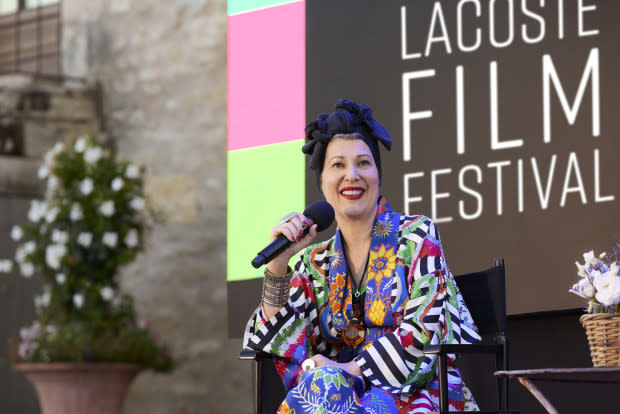
Photo: Courtesy of SCAD
Sure, the moment seems fortuitous, but Fitoussi actually harbored an ambition for costume design since childhood. She grew up in Toulouse surrounded by sartorial creativity from her seamstress mother and collector grandmother, who kept troves of clothing from the '50s to the '80s.
"I used to play a lot in my grandmother's attic, trying her clothes on and inventing different characters," she recalls. "I instinctively understood that you can tell stories with costumes. It's a strong way of communication."
As a child of the pre-internet '70s (and without easy access to museums and movies), she also mainlined television content to continuously spark her boundless imagination.
"One New Year's Eve, I watched 'Moulin Rouge,' and I discovered glitter, feathers, sequins, outrageous jewels," Fitoussi says. "That was my first aesthetic shock and I said, 'I want to go and to be part of this fantastic fantasy world and glamorous universe.'" The day after graduating high school, she jumped on a train to Paris to realize her big dreams.
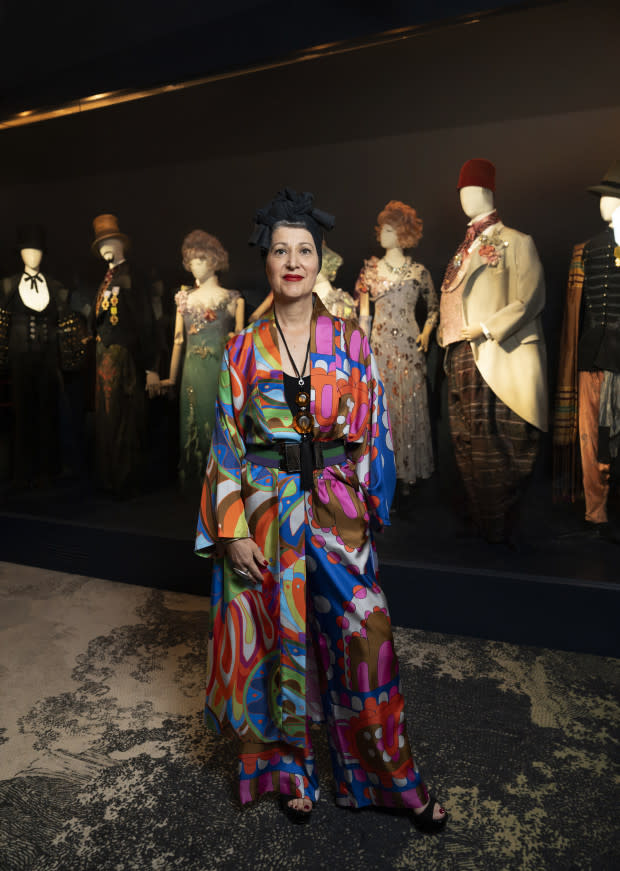
Photo: Courtesy of SCAD
For five years, Fitoussi assisted de Segonzac on four period films. And in the next three decades, she went on to travel the world and expand her skill set into fantasy and contemporary. Fitoussi has since cemented a name for herself with her distinctive signature: contemporary costume animated by fantastical high fashion and perfect vintage that's often in on the scripted humor. (Fitoussi's personal style is also memorable, influenced by her love of color and patterns, and her international experiences.)
Cut to the 2020 debut of "Sex and the City" creator Darren Star's Lily Collins vehicle, "Emily in Paris". Costume consultant (and longtime Star collaborator) Patricia Field needed a Paris-based costume designer with local expertise and connections — and ultimately hired Fitoussi.
"I decided on Marylin, and, believe me, that was a good decision," Field told Fashionista in 2020. Field remained a consultant for the first two seasons, and Fitoussi took full reins for the third, scoring her first Emmy nomination.
Ahead, Fitoussi shares what made the strongest impressions on Field in the hiring process, how she uses fashion to create timeless costumes and why aspiring designers should embrace "bad taste".
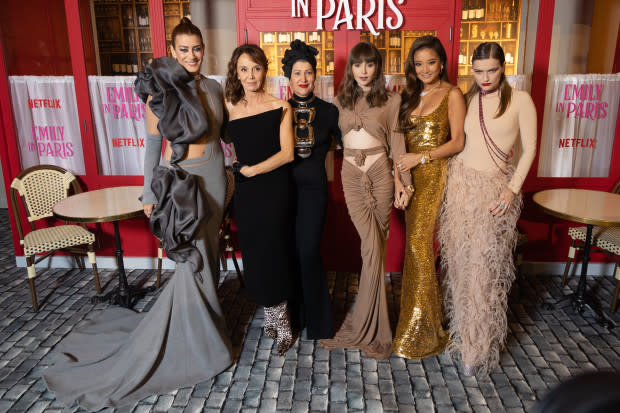
Photo: Marc Piasecki/WireImage
When you met Sylvie de Segonzac on the dancefloor at Le Bains Douches, what did you do to make her want to give you your big break?
I think because she had the feeling that I was passionate and that I loved costume. I love clothes — I'm not so much into fashion, [but clothes are] poetry. It's something that physically provokes me or [incites] a reaction, when I'm in front of a beautiful piece. She felt that way, too.
She had a period costume rental house [Les Costumes de Paris] that a French producer had built with Bing Crosby. It was very strange. So when I went to see her, I saw the marvelous pieces that she had, and [she could see that I was] really passionate about costume. I had this sensibility of fabrics, and I wanted to learn. Maybe she saw that I had big potential and that she needed to help me to grow.
The first movie you worked on with her was an 18th-century piece. How was designing period a training ground to help you grow your skills?
People are going to cry and shout, but period is much easier than contemporary movie costume design. Because you go to a library — or now, you have the internet — to research the period. Of course, now, you can decide to readapt or to modernize, but in the early '90s, we were really stuck to the period. We needed to almost replicate.
But it also opened my mind to learn different periods. You can always be inspired and mix contemporary creations with vintage or historical pieces because you understand different period silhouettes.
What was the first project where you felt like you were allowed to really be creative and push the boundaries?
What I really enjoyed — because I was much more mature, or I had the feeling that I was dominating in my skills and my universe a little bit more — was being an assistant for a 2014 French movie, 'Lou! Journal Infime.' It's a story about a teenager, [co-written and directed by] cartoonist Julien Neel, from a comic book that was very successful in France. I stepped completely into the universe of the cartoonist. It let me create everything: young, old, teenager. It's very stylish. It's actually very similar to 'Emily in Paris' because it's vintage mixed with very colorful pieces and a lot of patterns. We custom-made a lot of things.
By this time, I was 40-something. It takes time to be able to say, 'Yes, now I really know my job well.' But I think you're never completely satisfied with what you're you doing, and it's the fuel for doing another project and saying, 'Okay, this time it was it was good. Next time, I need to be spectacular. I need to be better.' You need to reinvent yourself all the time.
You've done fantasy, of course. You started with period. You do contemporary. What skills help you to be able to adapt to and also branch out into these different realms?
I'm curious to learn all the time [about different] people. That's why I keep myself busy. I need to read, watch, observe, do all these kinds of things. I read a lot — I really read a lot because that opens my imagination. I'm also very fond of Pinterest, where I see a lot of images and search a lot of different subjects. Everything is part of creativity.
Your 'Emily in Paris' costumes push the boundaries of imagination through fashion, and the response from the viewers has been very passionate. How do you feel about these reactions?
I didn't expect that. Since the beginning, I've been really curious, and I try to understand why this series was so successful. What does it mean for our society and for the young audience, who's copying the look and who throws parties where everybody's dressed like 'Emily in Paris'? I think it's because it was a manifesto of freedom, of saying to people, 'Be confident if you like to mix everything with everything. Allow yourself to think out of the box and be different and have your own vision — and a little bit of bad taste. It's like spice in the cooking. It's healthy, it's hearty, it's good.'
The Parisian was not dressed as Parisian, and that's why Parisians hated the show so much. But for the rest of the universe, it was like a fantasy. It's colorful. It's couture. It's heels. It's hair and makeup. It's sophistication. It's glam. I loved to have this idealized vision of Paris. I'm really not ashamed to be a part of it and [infuse] this project with this kind of aesthetic. We needed to be inspired and to have something easy and joyful to look at [when the show premiered in October 2020.]
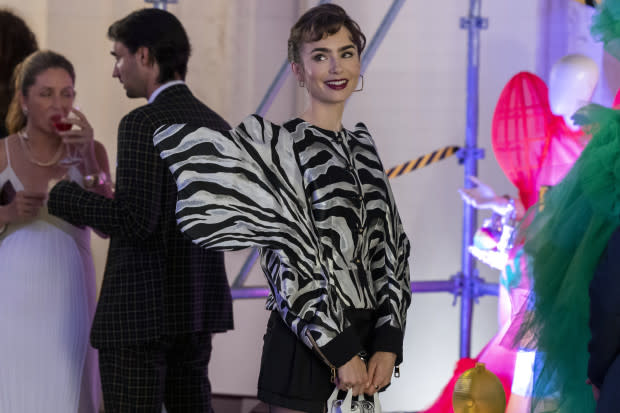
Photo: Marie Etchegoyen/Courtesy of Netflix
How did you connect with Patricia Field to start costume designing on the show?
I [interviewed along with] three English designers and another French one. The next day, they called me and said, 'Okay, you got the job.' Pat said, [as Fitoussi does an impression of Field's famous New York City-accented raspy voice] 'Because you're very unique.' Because, yes, I had the turban on and I'm not dressed as a 'Parisian.' She was expecting a Parisian with a white T-shirt and a navy blazer. Because I traveled a lot and I wasn't living in Paris and I had experience on American movies, I wasn't so 'Parisian' in my way of thinking. Because she felt that I could completely understand her vision and Darren's vision; she needed to find someone like a spiritual sister, who can drive the show as far as she can — and as I can — while respecting Darren's vision.
[Star] doesn't need to explain to me whatever he wants now. I can, in a very humble way, read his mind. I know his universe. I know that he likes color and hair and makeup and that he really takes care of every detail. He loves shoes. He loves handbags. He approves everything and sees every fitting that that we're doing.
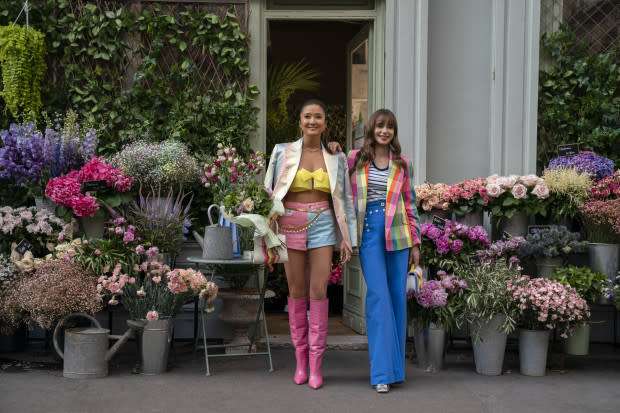
Photo: Stéphanie Branchu/Courtesy of Netflix
What type of prep did you do in order to be able to understand and anticipate him so well?
Watching 'Sex and the City' and his other shows, you can see what he likes. But 'Sex and the City,' particularly, was a little bit like... not a replica, but the same spirit [as 'Emily in Paris'], with another type of timeless fashion. Because we want this project to [endure] and, in 10 or 20 years, people can say, 'Oh yes, it was cool.'
Right, because such fantastical fashion can be also be timeless because when you look at it, you can't totally pinpoint what year or season it is, especially because you mix in vintage.
Yes, and because I'm studying every collection and every runway, I know the trend and the color of the year — and then I'll decide to avoid that trend. Like when fuchsia pink was the color of 2022, and Valentino did a collection all in fuchsia, I said, 'Okay, it's time to say goodbye to pink [on the show], because I can't repeat something that I have already done, and I don't want to use some strong statement in the current collections.' We avoid every detail that can tell you, 'That was very 2022 or 2018.'
The 'must-have pieces' bore me to tears. I need to offer the audience the chance to discover a young designer who's doing things that are different from something that you usually see in fashion magazines. For me, the show is a big chance to present emerging brands.
What's your process for keeping up with the up-and-coming designers you'd like to support on the show?
It's non-stop. We finished 'Emily' season three in August last year. Since that time, every day, I have two or three meetings with young designers that I find via Instagram or that a friend-of-a-friend who's a designer recommends to me. In Paris, we have the Tranoï salon during Paris Fashion Week, so you have emerging designers from all around the world. I spend days there, and I discover designers that I couldn't have imagined meeting before this show. I found Rich Mnisi, who's a South African designer, and I hope we can collaborate on season four — his use of color, patterns, everything... The shapes are incredible.
I'm super emotional to be able to present a new designer because I have a crush on them. I'm attracted to these kind of people who are different and think in a different way. That makes me [excited] to wake up every morning, and keeps me very passionate and enthusiastic about my job.
What advice do you have for young costume designers who maybe want to work on the next 'Sex and the City' or 'Emily in Paris?'
Be passionate. Trust your gut feelings. Trust your instinct. Don't pay attention if people make fun of you, if they criticize you. Don't waste your time with that. Show your vision. Success is the best revenge. You need to make mistakes. Don't be afraid of pushing your boundaries, of being different and of having bad taste.
This interview has been edited and condensed for clarity.
Disclosure: SCAD provided my travel and accommodations to attend the exhibit opening.
Never miss the latest fashion industry news. Sign up for the Fashionista daily newsletter.

